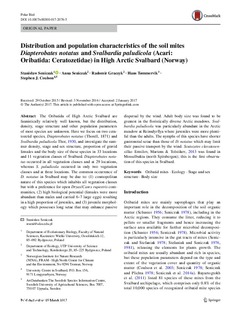| dc.description.abstract | The Oribatida of High Arctic Svalbard are faunistically relatively well known, but the distribution, density, stage structure and other population parameters of most species are unknown. Here we focus on two ceratozetid species, Diapterobates notatus (Thorell, 1871) and Svalbardia paludicola Thor, 1930, and investigate the summer density, stage and sex structure, proportion of gravid females and the body size of these species in 33 locations and 11 vegetation classes of Svalbard. Diapterobates notatus occurred in all vegetation classes and at 29 locations, whereas S. paludicola occurred in only two vegetation classes and at three locations. The common occurrence of D. notatus in Svalbard may be due to: (1) cosmopolitan nature of this species which inhabits all vegetation classes but with a preference for open Dryas/Carex rupestris communities, (2) high biological potential (females were more abundant than males and carried 6–7 large eggs) resulting in a high proportion of juveniles, and (3) juvenile morphology which possesses long setae that may enhance passive dispersal by the wind. Adult body size was found to be greatest in the floristically diverse Arctic meadows. Svalbardia paludicola was particularly abundant in the Arctic meadow at Reinsdyrflya where juveniles were more plentiful than the adults. The nymphs of this species have shorter gastronotal setae than those of D. notatus which may limit their passive transport by the wind. Scutozetes clavatosensillus Ermilov, Martens & Tolstikov, 2013 was found in Mosselbukta (north Spitsbergen); this is the first observation of this species in Svalbard. Oribatid mites · Ecology · Stage and sex structure · Body size | nb_NO |

